 |
Throughout the school year we are always
working on experiments. We have recorded some of this experimentation
and have placed the videos on "You Tube" and "Teacher Tube" so that students
can review our class lessons.
|
|
Science With Grambo - [Footer/NameAddr]
THE LOUIS ARMSTRONG MIDDLE SCHOOL 227Q
32-02 Junction Boulevard * East Elmhurst, New York 11369 * Phone: (718) 335-7500 * Fax: (718) 779-7186
|
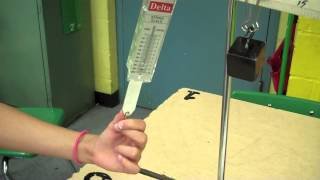 | First Class Lever S1
| This video shows how the simple machine called a First Class Lever moves an object. This lever uses a half meter stick, ring stand, 240g mass and a spring scale. |  |  |
|
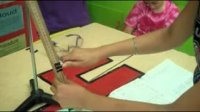 | Second Class Lever S2
| Using a half meter stick, ring stand, clamp, metal rod, spring scale and a 240g load, we set up a second class lever with the load in the middle of this lever system. |  |  |
|
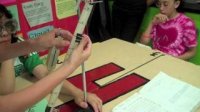 | Third Class Lever S3
| This video shows how the simple machine called a Third Class Lever moves an object. This lever uses a half meter stick, ring stand, 240g mass and a spring scale. |  |  |
|
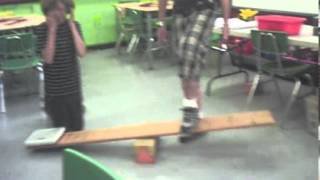 | Lift The Teacher S 4
| In this video, a single student, using only the strength of one hand, lifts the teacher off the floor using a simple machine called a First Class Lever |  |  |
|
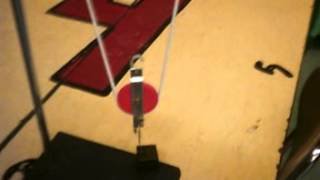 | Free Pulley S6
| In this video, we use the simple machine, the free pulley to lift an object. The pulley system is made from a ring stand, clamp, rod, pulley, 240g load and a spring scale. |  |  |
|
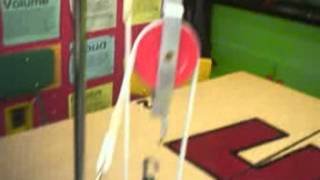 | Fixed and Free Pulley S7
| In this video we use two pulleys, a ring stand, clamp, metal rod, rope and a spring scale to lift a 240g mass. One pulley is put into a fixed position relative to the metal rod the other is free to move with the load. |  |  |
|
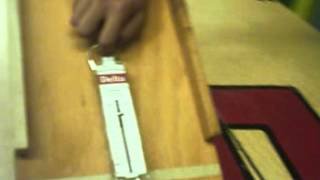 | Inclined Plane or Ramp S8
| In this video we are dragging a 240 g load up different inclines. Our goal is to see if the steepness of the incline will cause the load to move up the incline easier. |  |  |
|
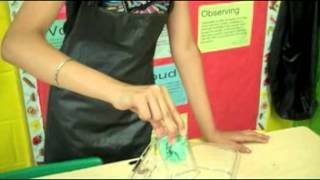 | Air Takes Up Space S12
| In this video we take an "empty" glass turn it upside down and plunge it into water. The water does not go into the cup. Something is keeping the water out. |  |  |
|
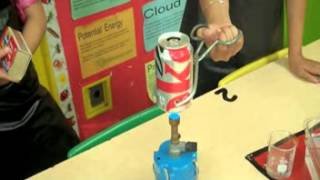 | Air Has Pressure - Can Crush S13
| In this experiment, we heat a soda can to add energy to the air molecules inside the can. The energized molecules move away from each other causing some pieces of air to leave the can. There is now more air outside the can than inside the can. When the can is sealed by touching the top of the can to water, the outside air crushes the can. |  |  |
|
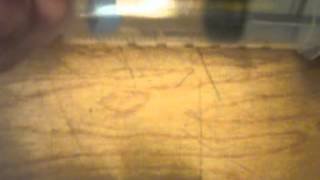 | Air Has Pressure - Syringe Experiment S14
| In this experiment, we use two hospital irrigation syringes and a piece of fish tank tubing to move air from one place to another and to force air into and out of the syringe. |  |  |
|
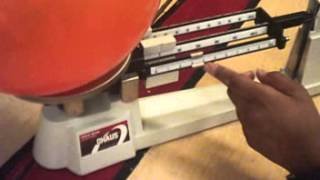 | Air Has Mass ? Balloon Experiment S15
| In this experiment we put a non filled balloon on a triple beam balance to find it?s mass. We then add air to the balloon and fill it up with air. The balloons end is tied into a knot to prevent air from escaping and the balloon is set on top of the pan of the balance once again so we can find the mass once more. |  |  |
|
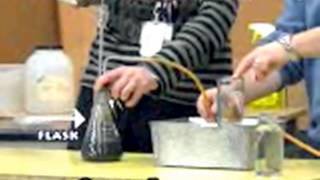 | What Is Air Made Of ? Making Oxygen S16
| In this classroom demonstration we are breaking apart hydrogen peroxide to make oxygen gas. The gas is collected and sent to a collection bottle. The gas is then tested with a glowing splint. |  |  |
|
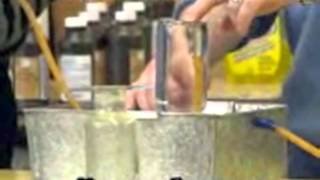 | What Is Air Made Of - Making Hydrogen S17
| In this classroom demonstration we make hydrogen gas by adding hydrochloric acid to zinc in a flask. The gas is collected and sent to a collection bottle. The gas is then tested with a lit splint. |  |  |
|
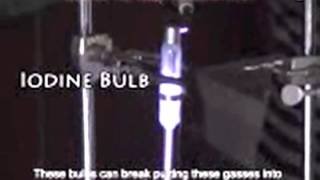 | What Is Air Made Of ? Electrifying Parts Of The Air S18
| In this demonstration we use a tesla coil to add energy to gasses that are in sealed tubes. The added energy excites the molecules in these gasses causing them to give off light. |  |  |
|
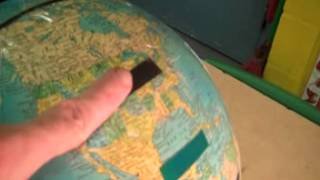 | How Heat Travels - Radiation ? Globe Experiment S21
| In this experiment, heat sensitive tape has been attached to the Northern Hemisphere of a globe in four places between the Equator and the North Pole. A heat lamp is aimed the equator of the globe. Students watch what happens to the four heat tapes over time.
|  |  |
|
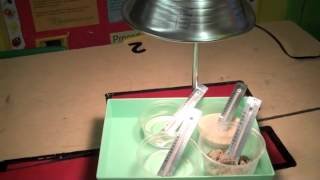 | How Heat Travels ? Radiation ? Soil Experiment S22
| In this experiment we heat samples of four substances with a heat lamp taking the temperature every three minutes for 15 minutes. At the end of this period the lamp is turned off, however, we continue to record the temperature every three minutes. Our goal is to see which sample heats up faster and which retains heat longer. |  |  |
|
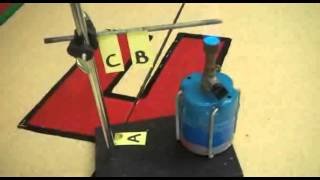 | How Heat Travels ? Conduction ? Card Fall S23
| In this experiment, three cards are attached to a steel bar using only wax. The bar is clamped into a ringstand. The cards are marked A, B and C. A Flame is put to the metal bar closest to card A. We want to see if heat will travel through the metal bar and move towards the cards. |  |  |
|
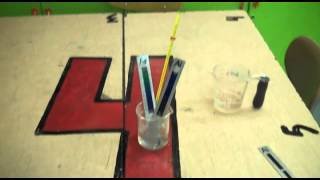 | How Heat Travels ? Conduction ? Metal Bars In Hot Water S24
| In this experiment, heat sensitive measuring tapes are attached to aluminum and iron bars. The bars are placed into hot water and the temperature is taken every 15 seconds. The temperature strips attached to the metal bars change color as heat is applied to them. |  |  |
|
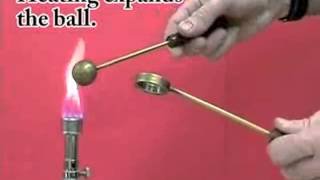 | How Heat Travels ? Conduction ? Ball and Ring S25
| In this experiment we have a brass ball and ring on separate handles. The ball just fits inside the ring. Heat energy is added to the ball from a Bunsen burner. The ball grows in volume as the molecules move away from each other. The ball no longer fits inside the ring. |  |  |
|
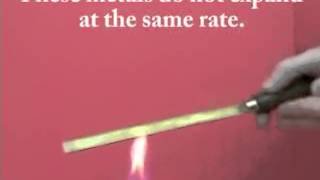 | How Heat Travels ? Bi Metallic Bar S 26
| In this experiment we want to see if different materials expand at the same rate. We use a bi-metallic bar with one side containing brass and the other containing stainless steel. As we add heat energy to the bar, the materials show that they do not heat up or expand at the same rate. |  |  |
|
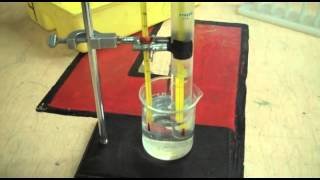 | How Heat Travels - Conduction In Liquids ? SWG 27
| In this experiment we want to see if water at different temperatures will transfer their temperatures, if the liquids are put in a situation where they touch each other. |  |  |
|
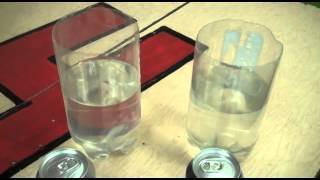 | Density ? Diet Soda and Regular Soda Cans In Water. SWG - 28
| In this demonstration we place unopened cans of regular and diet soda into a tank of water to see if they would float or sink. |  |  |
|
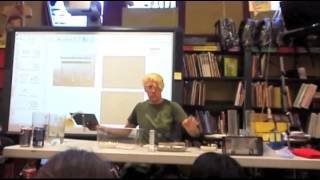 | How Heat Travels ? Convection ? Density ? New Convection Box ? SWG ? 34
| Hot air rising and cooler air coming in to take the place of the rising air is convection. I this video, we build an use a convection box made from a plastic shoe box, some tubing, a funnel and metal plate. |  |  |
|
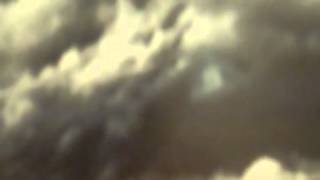 | Low Altitude Clouds ? SWG 37
| In this video we discuss low level clouds. These clouds form below 6,500 feet. |  |  |
|
 | Medium Altitude Clouds ?SWG 38
| In this video we discuss medium level clouds. These clouds form with bases at 6,500 to 20,000 feet above the surface of the earth. |  |  |
|
 | High Altitude Clouds - SWG 39
| In this video, we discuss clouds that are above 20,000 feet. These are called high level or high altitude clouds. |  |  |
|
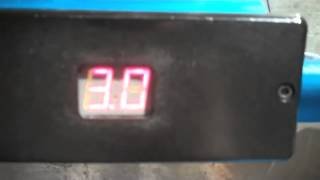 | Theme Park Fast Track ? Roller Coaster Speed- Inclined Plane ? SWG 40
| This video shows how the angle of the incline of a coaster track can cause a change in speed of the car riding on that track. |  |  |
|
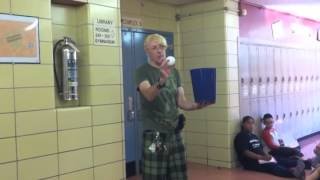 | Team Building Skills ? Group Games ? SWG ? 50
| These are three classroom activities to help foster students working together as a team in the science classroom. We start with a ring or hoola hoop activity. We move onto a can pass and then a mat flip activity |  |  |
|




















































































